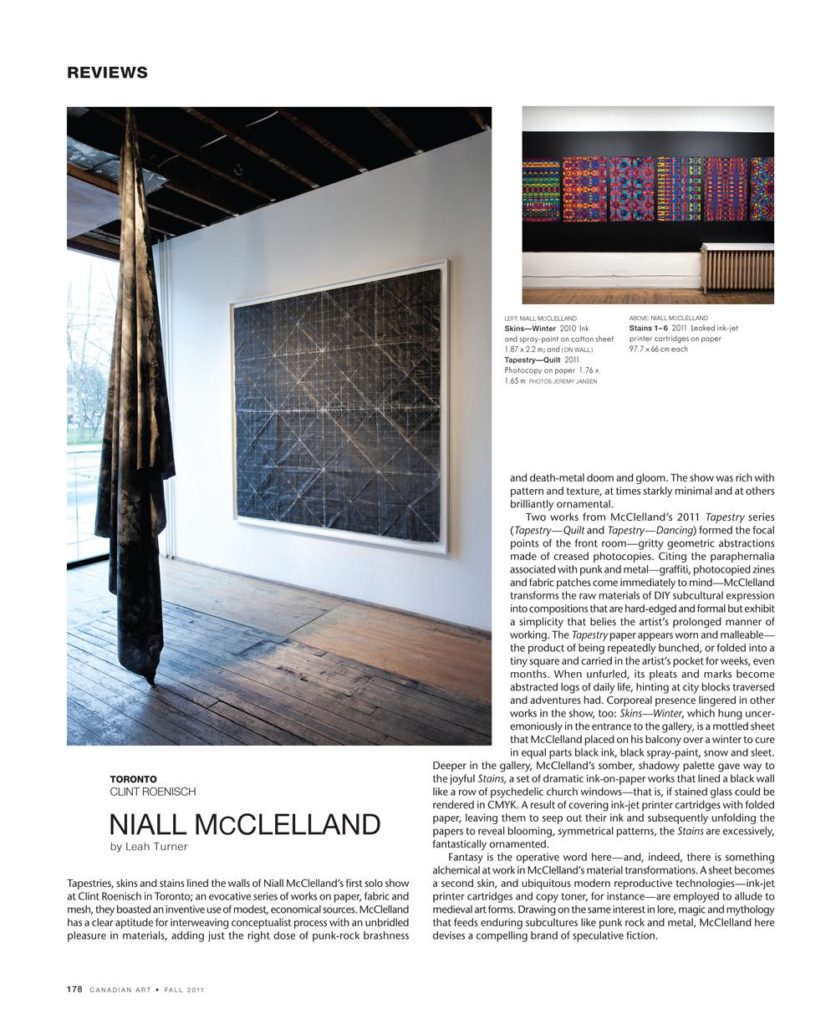Tapestries, skins and stains lined the walls of Niall McClelland’s first solo show at Clint Roenisch in Toronto; an evocative series of works on paper, fabric and mesh, they boasted an inventive use of modest, economical sources. McClelland has a clear aptitude for interweaving conceptualist process with an unbridled pleasure in materials, adding just the right dose of punk-rock brashness and death-metal doom and gloom. The show was rich with pattern and texture, at times starkly minimal and at others brilliantly ornamental.
Two works from McClelland’s 2011 Tapestry series (Tapestry—Quilt and Tapestry—Dancing) formed the focal points of the front room—gritty geometric abstractions made of creased photocopies. Citing the paraphernalia associated with punk and metal—graffiti, photocopied zines and fabric patches come immediately to mind—McClelland transforms the raw materials of DIY subcultural expression into compositions that are hard-edged and formal but exhibit a simplicity that belies the artist’s prolonged manner of working. The Tapestry paper appears worn and malleable—the product of being repeatedly bunched, or folded into a tiny square and carried in the artist’s pocket for weeks, even months. When unfurled, its pleats and marks become abstracted logs of daily life, hinting at city blocks traversed and adventures had. Corporeal presence lingered in other works in the show, too: Skins—Winter, which hung unceremoniously in the entrance to the gallery, is a mottled sheet that McClelland placed on his balcony over a winter to cure in equal parts black ink, black spray-paint, snow and sleet. Deeper in the gallery, McClelland’s somber, shadowy palette gave way to the joyful Stains, a set of dramatic ink-on-paper works that lined a black wall like a row of psychedelic church windows—that is, if stained glass could be rendered in CMYK. A result of covering ink-jet printer cartridges with folded paper, leaving them to seep out their ink and subsequently unfolding the papers to reveal blooming, symmetrical patterns, the Stains are excessively, fantastically ornamented.
Fantasy is the operative word here—and, indeed, there is something alchemical at work in McClelland’s material transformations. A sheet becomes a second skin, and ubiquitous modern reproductive technologies—ink-jet printer cartridges and copy toner, for instance—are employed to allude to medieval art forms. Drawing on the same interest in lore, magic and mythology that feeds enduring subcultures like punk rock and metal, McClelland here devises a compelling brand of speculative fiction.
This is an article from the Fall 2011 issue of Canadian Art. To read more from this issue, please visit its table of contents.

 Spread from the Fall 2011 issue of Canadian Art
Spread from the Fall 2011 issue of Canadian Art







